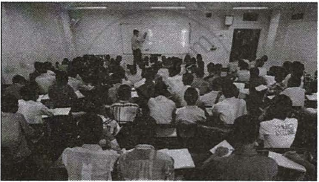Advertisements
Advertisements
प्रश्न
Read the following passage:
|
A coaching institute of Mathematics conducts classes in two batches I and II and fees for rich and poor children are different. In batch I, there are 20 poor and 5 rich children, whereas in batch II, there are 5 poor and 25 rich children. The total monthly collection of fees from batch I is ₹9,000 and from batch II is ₹26,000. Assume that each poor child pays ₹x per month and each rich child pays ₹y per month.
|
Based on the above information, answer the following questions:
- Represent the information given above in terms of x and y.
- Find the monthly fee paid by a poor child.
OR
Find the difference in the monthly fee paid by a poor child and a rich child. - If there are 10 poor and 20 rich children in batch II, what is the total monthly collection of fees from batch II?
उत्तर
i. Since, each poor child pays ₹ x
and each rich child pays ₹ y
∴ In batch I, 20 poor and 5 rich children pays ₹ 9000 can be represented as 20x + 5y = 9000
and In batch II, 5 poor and 25 rich children pays ₹ 26,000 can be represented as 5x + 25y = 26,000
ii. As we have 20x + 5y = 9,000 ...(1)
and 5x + 25y = 26,000
or x + 5y = 5,200 ...(2)
On subtracting (2) from (1), we get
19x = 3,800
`\implies` x = 200
∴ Monthly fee paid by a poor child = ₹ 200
OR
As we have,
20x + 5y = 9000 ...(i)
and 5x + 25y = 26000
x + 5y = 5200 ...(ii)
On subtracting equation (ii) from (i), we have
19x = 3800
x = `3800/19`
= 200
Put the value of x in equation (ii), we get
200 + 5y = 5200
5y = 5200 – 200
y = 1000
∴ y – x = 1000 – 200
= 800
Hence, difference in the monthly fee paid by a poor child and a rich child is ₹ 800.
iii. Total monthly fee = 10x + 20y
= 10(200) + 20(1,000)
= 2,000 + 20,000
= ₹ 22,000
APPEARS IN
संबंधित प्रश्न
Determine the values of a and b so that the following system of linear equations have infinitely many solutions:
(2a - 1)x + 3y - 5 = 0
3x + (b - 1)y - 2 = 0
Solve for x and y:
4x + 6y = 3xy, 8x + 9y = 5xy
Find the value of k for which the system of equations has a unique solution:
kx + 3y = (k – 3),
12x + ky = k
The difference between two numbers is 14 and the difference between their squares is 448. Find the numbers.
A man sold a chair and a table together for Rs. 1520, thereby making a profit of 25% on chair and 10% on table. By selling them together for Rs. 1535, he would have made a profit of 10% on the chair and 25% on the table. Find the cost price of each.
A train covered a certain distance at a uniform speed. If the train had been 5 kmph faster, it would have taken 3 hours less than the scheduled time. And, if the train were slower by 4 kmph, it would have taken 3 hours more than the scheduled time. Find the length of the journey.
Find the value of k for which the system of linear equations has an infinite number of solutions.
2x + 3y – 7 = 0,
(k – 1)x + (k + 2)y=3k
Find the value(s) of p in (i) to (iv) and p and q in (v) for the following pair of equations:
3x – y – 5 = 0 and 6x – 2y – p = 0,
if the lines represented by these equations are parallel.
Find the value(s) of p in (i) to (iv) and p and q in (v) for the following pair of equations:
– x + py = 1 and px – y = 1,
if the pair of equations has no solution.
A pair of linear equations which has a unique solution x = 2, y = –3 is ______.

